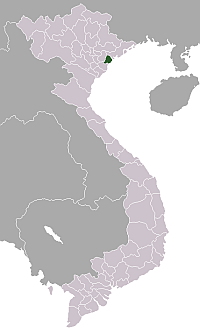Haiphong
|
|
| Name | |
| Name: | Thành Phố Hải Phòng |
| Meaning: | "coastal defence" |
| Geography | |
| Region: | Red River Delta |
| Area: | 1,503km² |
| People | |
| Population: | 1,711,100 |
| Ethnicities: | Viet, Hoa |
| Location | |

| |
Haiphong (Vietnamese: Hải Phòng, Chinese 海防) is the third most populous city in Vietnam.
Haiphong is located in the delta of the Red River. It is approximately 100 kilometres from Hanoi, the Vietnamese capital, and serves as the primary seaport for the northern region of the country.
Haiphong has existed as a significant port city for at least several centuries, and was one of Vietnam's principle trading centres. When Vietnam was conquered by the French, the city became France's main naval base in Indochina. After World War II, when Vietnam attempted to regain its independence, Haiphong was the site of the first military action undertaken by the French, being shelled by the French navy. Later, in the Vietnam War, the city was subjected to heavy bombing by the United States due to its status as North Vietnam's only major port. After the war, the city was built up as a significant industrial centre.
Administratively, Haiphong constitutes an independent municipality at the same level as Vietnam's provinces. It is divided into administrative units. Thuy Nguyen, An Hai, An Lao, Kien Thuy, Tien Lang, Vinh Bao are all districts. Cat Hai and Bach Long Vi, both also considered districts, are islands in the Gulf of Tonkin - Cat Hai is a larger island just off Haiphong's coast, while Bach Long Vi is a small island near the centre of the Gulf. Do Son, officially designated a town rather than a district, is a small settlement within the greater Haiphong area.
External link
- Haiphong government website (http://www.haiphong.gov.vn/en/index.asp?menuid=222&parent_menuid=222)de:Haiphong
